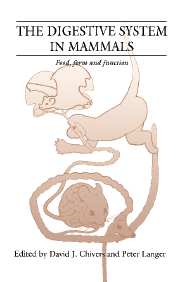Book contents
- Frontmatter
- Contents
- List of contributors
- Preface
- Part I Introduction
- 1 Gut form and function: variations and terminology
- 2 Food and digestion of Cenozoic mammals in Europe
- 3 Modelling gut function: an introduction
- 4 Optimum gut structure for specified diets
- Part II Food
- Part III Form
- Part IV Function
- Part V Synthesis and perspectives
- Index
1 - Gut form and function: variations and terminology
Published online by Cambridge University Press: 18 March 2010
- Frontmatter
- Contents
- List of contributors
- Preface
- Part I Introduction
- 1 Gut form and function: variations and terminology
- 2 Food and digestion of Cenozoic mammals in Europe
- 3 Modelling gut function: an introduction
- 4 Optimum gut structure for specified diets
- Part II Food
- Part III Form
- Part IV Function
- Part V Synthesis and perspectives
- Index
Summary
The aim in this volume is to present a synthesis of a wide range of data pertinent to the digestive system in mammals, focussing on three areas, food, form and function. There are introductions to each of these three sections and a final discussion encompassing all aspects but working from the viewpoints of the three groups of contributors. The essence of this volume is that it brings together very different lines of research, and that an integrating process is initiated to develop a broader understanding of the digestive system.
In this preliminary section we set the scene and discuss general, often problematic, issues and then Langer (Ch. 2) presents an evolutionary perspective. This is followed by introductions to modelling gut function by Martinez del Rio, Cork and Karasov (Ch. 3) and optimum gut structure for specified diets by McNeill Alexander (Ch. 4).
As we focus on the details of diets and digestive systems (structure and function), we need to think about the nature of the niches to which they are adapted: in particular, as to how broad or narrow these may be or how variable in the short (days) or long term (seasons, years). To what extent is form and function accounted for by preferred food and body size? To what extent are they moulded by critical events (‘bottlenecks’ in food availability). We need to think about them against an evolutionary background of increasing environmental diversity over the last 50 million years in relation to the dramatic radiation of angiosperm (flowering) plants.
- Type
- Chapter
- Information
- The Digestive System in MammalsFood Form and Function, pp. 3 - 8Publisher: Cambridge University PressPrint publication year: 1994
- 6
- Cited by

